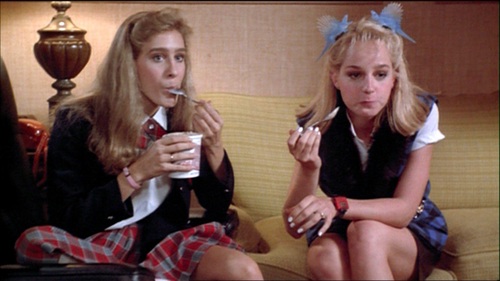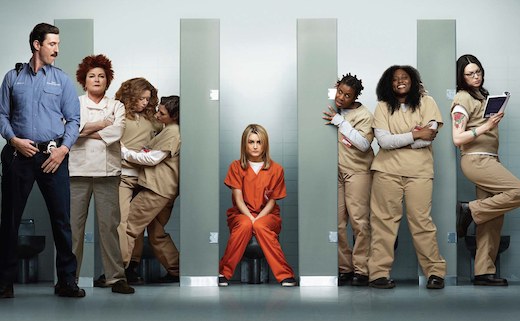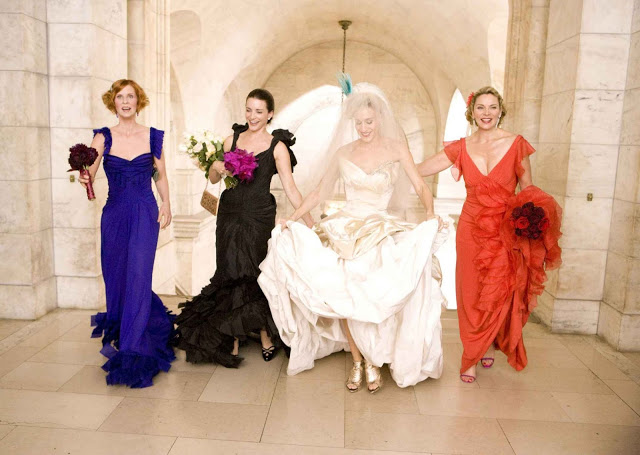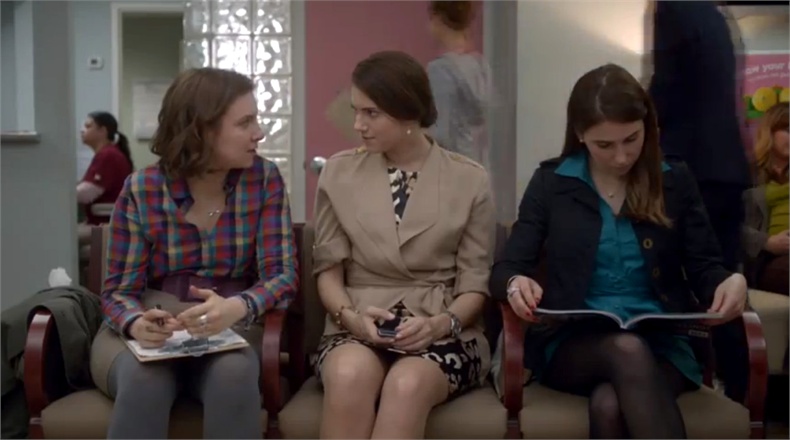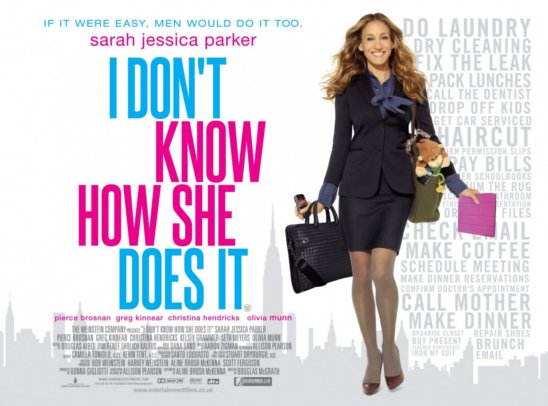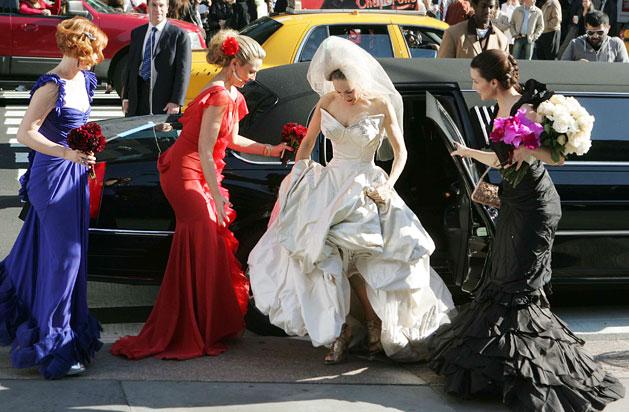
This guest post by Shay Revolver appears as part of our theme week on Movie Soundtracks.
The year was 1985. A very young and impressionable Shay had grown quite fond of the moving picture shows. She watched anything and everything. Some of them only once, others she recorded and watched over and over again. She was particularly fond of movies with a great soundtrack. Her older sister’s old bootleg copy of Rock ‘n’ Roll High School with the defiant, audacious and energetic PJ Soles was at the top of her list.
Then one day she came upon a new girl-powered (and probably more age-appropriate) film to love. This film would seal her belief that music and moving images go together like PB and J. It would imprint on her that the tone of a film could be realized through music and create a process by which the older Shay would write every script and edit every frame to a song. It wasn’t the first film that helped her see this beautiful pattern and it wouldn’t be the last, but it would definitely be the most fun. It would be a movie watched over and over again by a feisty little girl after school almost every day for a month in her Catholic school uniform and triple laced LA Gears. She would down all of the Fun Dip, eat all of the popcorn, and drink all the iced tea in the fridge while hanging out on the couch staring up at the big screen TV watching Girls Just Want to Have Fun.

For those of you that haven’t had the awesome pleasure of seeing this film I’m going to break it down for you: Army brat Janey Glenn (played by a very young Sarah Jessica Parker) gets transferred to Chicago with her family. She meets Lynne Stone (Helen Hunt) at her new Catholic all girls school. They become instant friends over their love of Dance TV, a nationwide TV show. When the opportunity presents itself for them to audition to become dancers on the show they couldn’t be happier; that is, until Janey’s super strict military dad puts his foot down and says NO. The story could end there, but Lynne convinces Janey to do it anyway. A majority of the movie is spent with Janey going behind her father’s back to practice with her partner, thwarting (and retaliating against) the evil plots of her rich girl nemesis, Natalie , falling in love with her “wrong side of the tracks” partner Jeff, and finally standing up to her dad, doing things her way and making her dreams come true.

I’m a lot older now and I still squeal with excitement when this film comes on. When it showed up on Netflix my daughter and I watched the movie over a dozen times. We would take “supreme silly” dance breaks whenever the music would play and when the Netflix purge occurred we found a DVD copy (OK we got two in case one got scratched or lost) of our very own on Amazon so that we could continue this tradition at will.

The thing about Girls Just Want to Have Fun is that it isn’t just about the girl power, female friendships, choosing your own destiny, standing up for what you believe in story line, it’s also about the music. In fact it’s so much about the music that it’s one of the few feature films whose soundtracks have their very own Wikipedia page. The music in the film isn’t just a soundtrack, it’s the story of their lives. It provides a freedom and excitement that is needed to propel the story (and in some ways the girls’ lives) along.
[youtube_sc url=”https://www.youtube.com/watch?v=ILXC6S6UZf4&index=3&list=PL8B90EF1762DB0144″]
Each song plays at the perfect time in the story and the music gets more and more intense as Janey breaks out of her shell, pulls away from who her father and society expect her to be and becomes the person she wants to be, or has always been but, not had a chance to discover.
[youtube_sc url=”https://www.youtube.com/watch?v=TBVfBFhLYnw”]
The music is Janey in some ways and follows her path throughout the film from the innocent pop music in the beginning as a naive and sheltered Janey begins to explore the world, to the woeful soul music as she faces disappointment, hopelessness, and obstacles on her way to accomplishing her goals, to the “punk” music that plays when she breaks out and begins to express and stand up for herself.
[youtube_sc url=”https://www.youtube.com/watch?v=QRRKmh6mTpI&list=PL8B90EF1762DB0144&index=8″]
Each note, lyric, and melody seems carefully curated to what’s happening on screen. The soundtrack plays in the background like an extra character in the film. It goes so smoothly with the images on the screen that it seamlessly integrates with the film becoming way more than background audio.

One of the things that makes this film and its soundtrack so memorable is that you feel every note. When the music plays you feel compelled to get up and dance along, which for the record is why it’s good that this film can be viewed in the comfort of your own home. The music even creates a freeing emotional release in the end when Janey’s father shows up to stop her from doing the final dance off to secure her spot on the show against her monied rival Natalie. As the song plays in the background you know before her dad does or even Janey does that despite seeing her dad, she isn’t going to be that good little girl she had always been. She’d grown up a bit and the defiance in the music shows that.
[youtube_sc url=”https://www.youtube.com/watch?v=TASGl0_jnjU”]
You could just feel through the music that she was going to acknowledge her father’s presence and do what she felt was right in her heart. She was going to dance, despite the consequences or incurring her father’s disapproval, disappointment, or wrath. When it was all said and done Janey grew up to the music and we all cheered and danced along with her. Even her hard-nosed father came around. He was proud of her and she had gained his respect.

As an avid film (and music) lover, this was one of the films that inspired me. It was all about being bold, blazing your own path and figuring out who you are for you. The music didn’t overshadow the film or try to be hip by using the music of the “kids” and coming off as messy or chaotic. It helped tell the story in such a way that it became a part of the story and it taught me that sometimes you’ve just got to dance, a lesson that I gladly share with my little mouseling whether we’re watching this movie or just baking cookies in the kitchen. It also taught a nation of little girls that sometimes it’s OK to be different, to fight the system, to follow your heart, and let it lead you to your dreams. And in a world where girls are still often taught to be seen and not heard, to be obedient without question and to play nice, everything about Girls Just Want to Have Fun was a welcome wake-up call.
